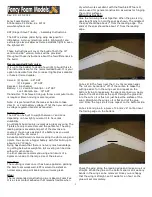
ɸ
Nano 4 user manual
________________________________________________________________________________________________________________________________________________________
ɸ
Dangerous situations and extreme flying
Dangerous situations
Pilot error, extreme wind conditions or turbulence which goes unnoticed by the pilot for too
long may leave the wing in an unusual flying position, requiring special reaction and skills on
the part of the pilot.
Ground-training is a safe and effective method of familiarising yourself with your glider’s
reactions. Launch can be practised, as can small flying manoeuvres, such as stall, asymmetric
collapse, front stall etc.
Any pilot who flies in turbulent conditions or who makes an error in handling the glider is at
risk of getting into an extreme situation. All of the extreme flight figures and flight attitudes
described here are dangerous if they are carried out with inadequate knowledge, without the
right safety altitude or without training.
Always keep within the recommended limits. Avoid aerobatics and extreme loading such as
spirals. This will prevent accidents and avoid overloading the glider.
In turbulent conditions, always keep enough distance from rock faces and other obstacles.
Time and sufficient altitude are needed to recover from extreme situations.
WARNING: Deploy your reserve if the corrective manoeuvres described in the following
sections do not return the glider to a controllable flying position or if there is not enough
altitude for correction.
SIV / Safety training
SIV / safety training is not recommended with the Nano 4.
Material stress
Uncontrolled flight positions may occur which are outside the manufacturer limits of the
speedriding glider. This may cause premature ageing, or even structural failure.
Stretching of the lines and/or canopy material after safety training can lead to a general
deterioration in flight characteristics.
Damage as a result of safety training is not covered by the warranty.
Canopy Collapses
Asymmetric collapses
Asymmetric collapses are caused by the stagnation point moving to the trailing edge of the
glider. A negative angle of attack makes part of the canopy collapse and tuck under, and the
glider may plunge down, turn away or spin.
Use active flying techniques to virtually eliminate collapses in normal flying conditions.
Nevertheless, if you do get a collapse, stabilize your weight in your harness and do not allow
yourself to fall to the collapsed side. Control your course with weightshift and a little outside
brake. The deflation should re-inflate spontaneously.
ɸ
ɸ
ɸ
ɸ
Page 23
Summary of Contents for Nano 4
Page 1: ...Nano 4 User manual v1 0 December 2017...
Page 45: ...Dream Touch Believe...
















































